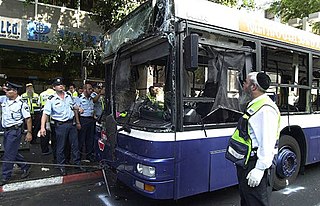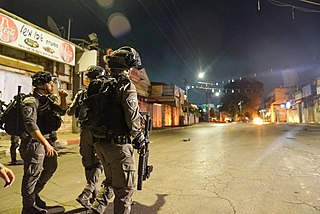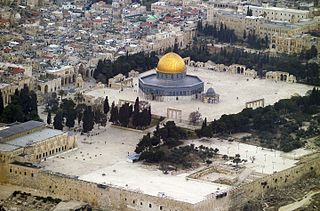Related Research Articles

The Second Intifada, also known as the Al-Aqsa Intifada, was a major Palestinian uprising against Israel. The general triggers for the unrest are speculated to have been centred on the failure of the 2000 Camp David Summit, which was expected to reach a final agreement on the Israeli–Palestinian peace process in July 2000. Outbreaks of violence began in September 2000, after Ariel Sharon, then the Israeli opposition leader, made a provocative visit to the Al-Aqsa compound on the Temple Mount in Jerusalem; the visit itself was peaceful, but, as anticipated, sparked protests and riots that Israeli police put down with rubber bullets and tear gas.
The International Solidarity Movement (ISM) is a Palestinian-led movement focused on assisting the Palestinian cause in the Israeli–Palestinian conflict. ISM is dedicated to the use of nonviolent protests and methods only. The organization calls on civilians from around the world to participate in acts of nonviolent protests against the Israeli military in the West Bank and the Gaza Strip.

The 2000 Ramallah lynching was a violent incident that took place on October 12, 2000 – early in the Al-Aqsa Intifada – at the el-Bireh police station, where a Palestinian crowd of passing funeral marchers broke in and killed and mutilated the bodies of two Israel Defense Forces reservists.
In 2009, clashes between Muslim Palestinians and Israeli police erupted on September 27, 2009, and continued to late October. Violence spread through East Jerusalem and parts of the West Bank, and included throwing of Molotov cocktails and stones at Israeli security forces and civilians. Israeli police responded with arrests of rioters and sporadic age-based restriction of access to the Temple Mount. Several dozen rioters, police and Israeli civilians have been injured.
This is a list of individual incidents and statistical breakdowns of incidents of violence between Israel and Palestinian dissident factions in 2014 as part of the Israeli–Palestinian conflict.
List of violent events related to the Israeli-Palestinian conflict occurring in the second half of 2015.

An increase of violence occurred in the Israeli–Palestinian conflict starting in the autumn of 2015 and lasting into the first half of 2016. It was called the "Intifada of the Individuals" by Israeli sources, the "Knife Intifada", "Stabbing Intifada" or "Jerusalem Intifada" by international sources because of the many stabbings in Jerusalem, or "Habba" by Palestinian sources.
This is a Timeline of events related to the Israeli–Palestinian conflict during 2016.
The following is a timeline of events during the Israeli–Palestinian conflict in 2017.

The 2017 Temple Mount crisis was a period of violent tensions related to the Temple Mount, which began on 14 July 2017, after a shooting incident in the complex in which Palestinian gunmen killed two Israeli police officers. Following the attack, Israeli authorities installed metal detectors at the entrance to the Mount in a step that caused large Palestinian protests and was severely criticized by Palestinian leaders, the Arab League, and other Muslim leaders, on the basis that it constituted a change in the "status quo" of the Temple Mount entry restrictions.
The following is a timeline of events during the Israeli–Palestinian conflict in 2018.

Gaza-Israel clashes began on 11 November 2018, when a botched Israeli covert operation carried out in the Khan Yunis area of the southern Gaza Strip killed seven Palestinian militants and one Israeli soldier. Exchanges of fire lasted for two more days, until a cease fire was achieved with Egyptian mediation. Some minor incidents and protests followed some two weeks after the cease fire, with decreasing intensity.
The following is a timeline of events during the Israeli–Palestinian conflict in 2020.

A major outbreak of violence in the ongoing Israeli–Palestinian conflict commenced on 10 May 2021, though disturbances took place earlier, and continued until a ceasefire came into effect on 21 May. It was marked by protests and police riot control, rocket attacks on Israel by Hamas and Palestinian Islamic Jihad (PIJ), and Israeli airstrikes in the Gaza Strip. The crisis was triggered on 6 May, when Palestinians in East Jerusalem began protesting over an anticipated decision of the Supreme Court of Israel on the eviction of six Palestinian families in the neighborhood of Sheikh Jarrah. Under international law, the area, effectively annexed by Israel in 1980, is a part of the Palestinian Territories; Israel applies its laws there. On 7 May, according to Israel's Channel 12, Palestinians threw stones at Israeli police forces, who then stormed the Al-Aqsa Mosque compound using tear gas, rubber bullets, and stun grenades. The crisis prompted protests around the world as well as official reactions from world leaders.
The following is a timeline of events during the Israeli–Palestinian conflict in 2021, including the 2021 Israel–Palestine crisis.
The following is a list of events during the Israeli–Palestinian conflict in 2022.

On 15 April 2022, clashes erupted between Palestinians and Israeli Security Forces on the Al-Aqsa Compound in the Old City of Jerusalem. According to the United Nations Special Coordinator for the Middle East Peace Process, the clashes began when Palestinians threw stones, firecrackers, and other heavy objects at Israeli police officers. The policemen used tear gas shells, stun grenades and police batons against the Palestinians. Some Palestinians afterwards barricaded themselves inside the Al-Aqsa Mosque and proceeded to throw stones at the officers. In response, police raided the mosque, arresting those who had barricaded themselves inside. In addition, some damage was done to the mosque's structure.
Events in the year 2022 in the Palestinian territories.
The following is a list of events during the Israeli–Palestinian conflict in 2023.
References
- ↑ "Timeline | Shattered Dreams Of Peace | FRONTLINE | PBS". www.pbs.org. Retrieved 2022-11-13.
- 1 2 3 4 5 6 7 8 Andrew Lawler. "No Way Out: How the Opening of a Tunnel Blocked the Path to Peace in Jerusalem". POLITICO. Retrieved 2022-11-13.
- ↑ "Notes on the Rabbinical Tunnel". www.templemount.org. Retrieved 2022-11-13.
- ↑ "CNN - Peres: Netanyahu wants 'peace for nothing' - Sept. 26, 1996". 2005-01-13. Archived from the original on 2005-01-13. Retrieved 2022-11-13.
- ↑ "Tunnel Opening in Jerusalem Sparks Protests - Los Angeles Times". Los Angeles Times . 2022-05-02. Archived from the original on 2022-05-02. Retrieved 2022-11-13.
- 1 2 3 ARAB-ISRAEL CLASH LEAVES FIVE DEAD IN THE WEST BANK 26 Sept 1996, The New York Times.
- ↑ MacFarquhar, Neil (27 September 1996). "For Jews, a Split Over Peace Effort Widens". The New York Times. Archived from the original on 26 May 2015. Retrieved 11 November 2022.
- 1 2 3 4 5 6 "50 ARE KILLED AS CLASHES WIDEN FROM WEST BANK TO GAZA STRIP - The New York Times". The New York Times . 2021-11-27. Archived from the original on 2021-11-27. Retrieved 2022-11-13.
- ↑ "For Jews, a Split Over Peace Effort Widens - NYTimes.com". The New York Times . 2015-05-26. Archived from the original on 2015-05-26. Retrieved 2022-11-13.
- 1 2 3 4 "10 MORE DIE IN MIDEAST RIOTS AS VIOLENCE ENTERS 3D DAY; MOSQUE IS SCENE OF A CLASH - The New York Times". The New York Times . 2022-06-16. Archived from the original on 2022-06-16. Retrieved 2022-11-13.
- ↑ "CNN - Flurry of meetings seek to end Israeli-Palestinian fighting - Sept. 26, 1996". 2005-03-08. Archived from the original on 2005-03-08. Retrieved 2022-11-13.
- ↑ Year: 1996), UN Security Council (51st (1996-09-28). "Resolution 1073 (1996) /".
{{cite journal}}: Cite journal requires|journal=(help)